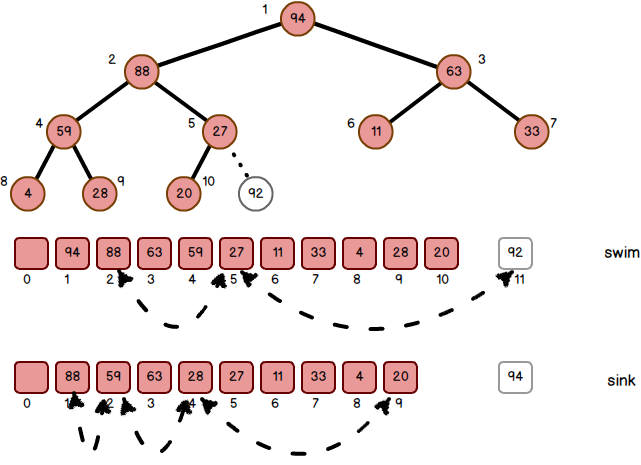C++<优先队列>
一、相关定义
普通的队列具有先进先出的特性,元素追加在队尾,如果删除的话,从队头删除。
而在优先队列中,队列中的数据被赋予了优先级;
当访问元素时,优先级最高的会先被删除;
所以说优先队列是最高级数据先出。
优先级队列可以用向量(vector) 或 双向队列(deque) 来实现(注意list容器不能用来实现queue),STL默认使用vector,而且是大堆(less);
因为list的迭代器不是任意存取iterator,而pop中用到堆排序时是要求随机存取iterator 的!)
priority_queue<vector<int>, less<int> > pq1; // 使用递增less<int>函数对象排序
priority_queue<deque<int>, greater<int> > pq2; // 使用递减greater<int>函数对象排序
//greater和less是std实现的两个仿函数(就是使一个类的使用看上去像一个函数。其实现就是类中实现一个operator(),这个类就有了类似函数的行为,就是一个仿函数类了)
其成员函数有“判空(empty)” 、“尺寸(Size)” 、“栈顶元素(top)” 、“压栈(push)” 、“弹栈(pop)”等。
二、priority_queue
基本操作:
- empty() 如果队列为空,则返回真
- pop() 删除对顶元素,删除第一个元素
- push() 加入一个元素
- size() 返回优先队列中拥有的元素个数
- top() 返回优先队列对顶元素,返回优先队列中有最高优先级的元素
在默认的优先队列中,优先级高的先出队。
在默认的int型中先出队的为较大的数。
头文件:
#include <queue>
声明方式:
1、普通方法:
priority_queue<int> q; //通过操作,按照元素从大到小的顺序出队
priority_queue<int,vector<int>, greater<int> > q; //通过操作,按照元素从小到大的顺序出队
2、自定义优先级:
struct cmp {
operator bool ()(int x, int y)
{
return x > y; // x小的优先级高 //也可以写成其他方式,如: return p[x] > p[y];表示p[i]小的优先级高
}
};
priority_queue<int, vector<int>, cmp> q; //定义方法
//其中,第二个参数为容器类型。第三个参数为比较函数。
3、结构体声明方式:
struct node {
int x, y;
friend bool operator < (node a, node b)
{
return a.x > b.x; //结构体中,x小的优先级高
}
};
priority_queue<node>q; //定义方法
//在该结构中,y为值, x为优先级。
//通过自定义operator<操作符来比较元素中的优先级。
//在重载”<”时,最好不要重载”>”,可能会发生编译错误
三、那么如何使用呢?
1、基本类型优先队列的例子:
#include<iostream>
#include <queue>
using namespace std;
int main()
{
//对于基础类型 默认是大顶堆
priority_queue<int> a;
//等同于 priority_queue<int, vector<int>, less<int> > a;
priority_queue<int, vector<int>, greater<int> > c; //这样就是小顶堆
priority_queue<string> b;
for (int i = 0; i < 5; i++)
{
a.push(i);
c.push(i);
}
while (!a.empty())
{
cout << a.top() << ' ';
a.pop();
}
cout << endl;
while (!c.empty())
{
cout << c.top() << ' ';
c.pop();
}
cout << endl;
b.push("abc");
b.push("abcd");
b.push("cbd");
while (!b.empty())
{
cout << b.top() << ' ';
b.pop();
}
cout << endl;
return 0;
}
2、用pair做优先队列元素的例子:
先比较frist,如果frist相等,那么就比较第二个
```cpp
#include
#include
#include
using namespace std;
int main()
{
priority_queue<pair<int, int> > a;
pair<int, int> b(1, 2);
pair<int, int> c(1, 3);
pair<int, int> d(2, 5);
a.push(d);
a.push©;
a.push(b);
while (!a.empty())
{
cout << a.top().first << ’ ’ << a.top().second << ‘\n’;
a.pop();
}
}
### 3、用自定义类型做优先队列元素的例子
```cpp
#include <iostream>
#include <queue>
using namespace std;
//方法1
struct tmp1 //运算符重载<
{
int x;
tmp1(int a)
{
x = a;
}
bool operator<(const tmp1& a) const
{
return x < a.x; //大顶堆
}
};
//方法2
struct tmp2 //重写仿函数
{
bool operator() (tmp1 a, tmp1 b)
{
return a.x < b.x; //大顶堆
}
};
int main()
{
tmp1 a(1);
tmp1 b(2);
tmp1 c(3);
priority_queue<tmp1> d;
d.push(b);
d.push(c);
d.push(a);
while (!d.empty())
{
cout << d.top().x << '\n';
d.pop();
}
cout << endl;
priority_queue<tmp1, vector<tmp1>, tmp2> f;
f.push(b);
f.push(c);
f.push(a);
while (!f.empty())
{
cout << f.top().x << '\n';
f.pop();
}
}
示意图:























 1万+
1万+











 被折叠的 条评论
为什么被折叠?
被折叠的 条评论
为什么被折叠?








